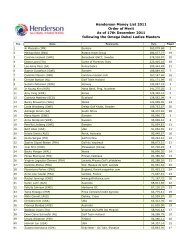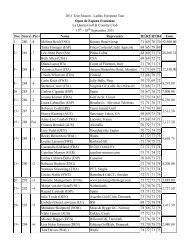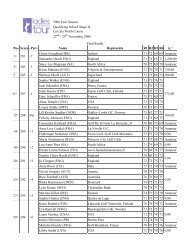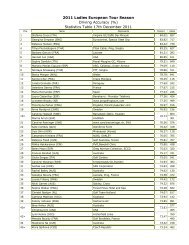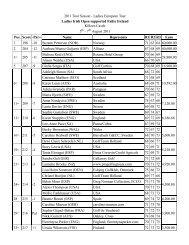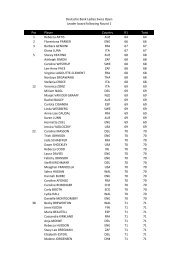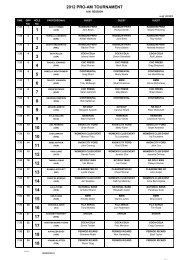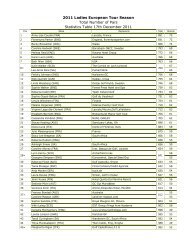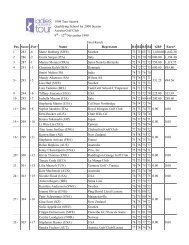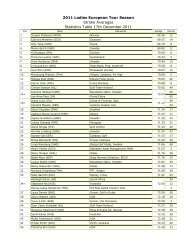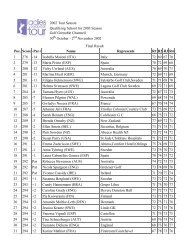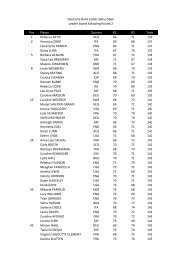2013 LET Tour Guide (pdf) - Ladies European Tour
2013 LET Tour Guide (pdf) - Ladies European Tour
2013 LET Tour Guide (pdf) - Ladies European Tour
You also want an ePaper? Increase the reach of your titles
YUMPU automatically turns print PDFs into web optimized ePapers that Google loves.
The History of The Solheim Cup<br />
The Solheim Cup was founded in 1990, when the sponsor Karsten Manufacturing Corporation<br />
(manufacturers of PING golf equipment) decided that women professional golfers should have an<br />
equivalent event to The Ryder Cup.<br />
The event was named after the company’s founder Karsten Solheim and took the form of a biennial<br />
transatlantic team matchplay competition between <strong>European</strong> members of the <strong>Ladies</strong><br />
<strong>European</strong> <strong>Tour</strong> (<strong>LET</strong>) and the <strong>Ladies</strong> Professional Golf Association (LPGA).<br />
The format of the event has evolved over the years. The first event was played at Lake Nona in Florida<br />
with 16 points at stake. Four pairings from each team played in the initial foursomes matches, which<br />
was followed by four more points being played for in the fourball matches. On the final day’s play the<br />
remaining eight points were decided by eight singles matches. Unfortunately for the <strong>European</strong>s the<br />
home side took charge from the start, eventually winning the trophy 11 1 ⁄2 - 4 1 ⁄2.<br />
Two years later, two more points were introduced to the final day’s singles and the <strong>European</strong>s took<br />
their revenge on their American counterparts, winning the tie 11 1 ⁄2 - 6 1 ⁄2 at Dalmahoy GC in Scotland.<br />
Back in the USA in 1994, the event developed further, with one more fourball and one extra<br />
foursomes match pushing the total points available up to 20. For the third time the home side was<br />
victorious, with the Americans winning 13 - 7.<br />
In line with the growth in popularity of both of the <strong>Tour</strong>s, eight more matches were introduced into the<br />
event in 1996. Instead of playing one match a day, competitors would play a foursomes match each<br />
of the first two mornings and a fourball in the afternoons. With two extra matches introduced into the<br />
singles, this brought the tally up to 28 for the event and mirrored the men’s Ryder Cup format.<br />
After two close days at the Marriot St Pierre Hotel and Country Club in Wales, the Americans clinched<br />
the Solheim Cup’s first away victory, winning the singles 10 - 2 and the tie 17 - 11. The format stayed<br />
the same back in the States for the fifth Solheim Cup tie and the Americans successfully retained the<br />
Cup for the third time running, winning the event 16 - 12.<br />
But the event received another modification when it moved to a new 26-point format at Loch Lomond<br />
in 2000. The matches featured four Foursome Matches in the morning of day one, followed by four in<br />
the afternoon. Day two would bring six Fourball Matches only and in a thrilling final day of 12 singles<br />
matches, Europe defied the critics when they snatched victory from the Americans.<br />
In 2002 at Interlachen GC, the format reverted to the 28-point format to mirror the Ryder Cup<br />
matches as it was in 1996. This format continued in future Solheim Cup matches.<br />
At Interlachen in 2002, the event was full of sudden swings and lead changes, as well as one of the<br />
most closely contested Solheim Cups to date. Europe won three of four morning foursomes matches<br />
on Friday, but the US Team rallied to win three of four four-ball matches in the afternoon to tie the<br />
competition at 4 - 4 after the first day. The home team’s momentum carried over into the morning<br />
foursome matches on Saturday, where they won three of four matches to take a 7 - 5 lead. But the<br />
tide turned again in the afternoon as the <strong>European</strong>s swept the four-ball matches to take a<br />
commanding 9 - 7 lead into the final day.<br />
The US Team, led by Patty Sheehan, showed their strength in the singles matches on Sunday,<br />
winning seven of 12 matches and halving three. Wendy Ward, who took world-number-one Annika<br />
<strong>Ladies</strong> <strong>European</strong> <strong>Tour</strong> <strong>2013</strong><br />
290




